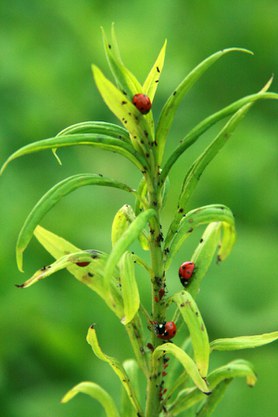 How do you feel about some visitors this fall? No – not the human kind - the winged, six-legged kind looking to over-winter in the comfort of your house and share your protecting space and heat in order to move outside again next spring and continue their normal life cycles.
How do you feel about some visitors this fall? No – not the human kind - the winged, six-legged kind looking to over-winter in the comfort of your house and share your protecting space and heat in order to move outside again next spring and continue their normal life cycles.
Bugs, beetles, flies and other creepy-crawlers just love to use the available facilities (namely your probably light colored house) as a survivalist vacation hotel – thank you very much!
Who are they and what can be done to avoid their visitation?
Most folks are aware of the habits of the multi-colored Asian lady beetle and the bad odors given off when disturbed; their numbers increase this time of year when the soy bean aphids are plentiful and with the lowering of temperatures they will begin to seek refuge. They see the light-colored siding on your house as a cliff in their native country and flock in huge
numbers to safety. They mean no harm, they do not eat or reproduce nor carry disease – they are doing what comes naturally to keep their species alive, but their presence is hard to tolerate to say the least.
The brown marmorated stink bug is another misunderstood insect just trying to survive but their presence is more than just a nuisance or an invasion of your comfort zone, stink bugs are so named for a reason – they stink when crushed. Remember this when handling this problem!
Cluster flies gather, as their name suggests, in groups in window sills on warm winter days and buzz around lethargically. Again, they do no harm or pose any health problem but the nuisance value is high. A fly swatter is the best weapon here – I have already begun to use mine…
Boxelder bugs gather on the sides of houses in huge numbers in the fall after a summer of infesting boxelder trees (not necessarily on your property). This is a black insect with red edges on the wings and top of the body and a red ‘vee’ in the middle of the back.
This is a run-down of the more likely suspects to invade your house and the same control strategies will work for all:
- In small numbers collect by hand and put them in a plastic bag; a quicker death is obtained by popping the bag in the freezer.
- Vacuuming works well, but remember to empty the bag to prevent the bugs from crawling out, or creating an awful stench when dead.
- Exclusion in the first place is the best defense; seal windows and screens and under door sills; caulk around pipes, vents and behind chimneys. Don’t forget to screen the attic vents!
- There are some traps on the market with varying degrees of effectiveness. Please follow all directions.
- Foggers or insecticide sprays are not recommended inside the house. Foggers only kill exposed insects and do not do a good job of penetrating inside the wall cavities. Toxic sprays are never a good idea around humans or pets in an enclosed space.
This brings me to my particular problem – millipedes. These crawly ‘worms’ are usually a mid-summer pest; they are the ones that curl up in a ‘c’ shape when disturbed and become crunchy when dead. I have just ‘bagged’ thousands of them in my garage. Daily I put out sticky traps, and next day have to replace them as they are covered in ‘stuck’ bugs. Wrong season, and
confused aspirations – I wonder what caused this aberration…They don’t seem to understand that I have no intention of sharing my space with a crunchy ‘worm’!
Final words: fruit flies? Vinegar traps!
Read other articles about insects & garden pests
Read other fall related gardening articles